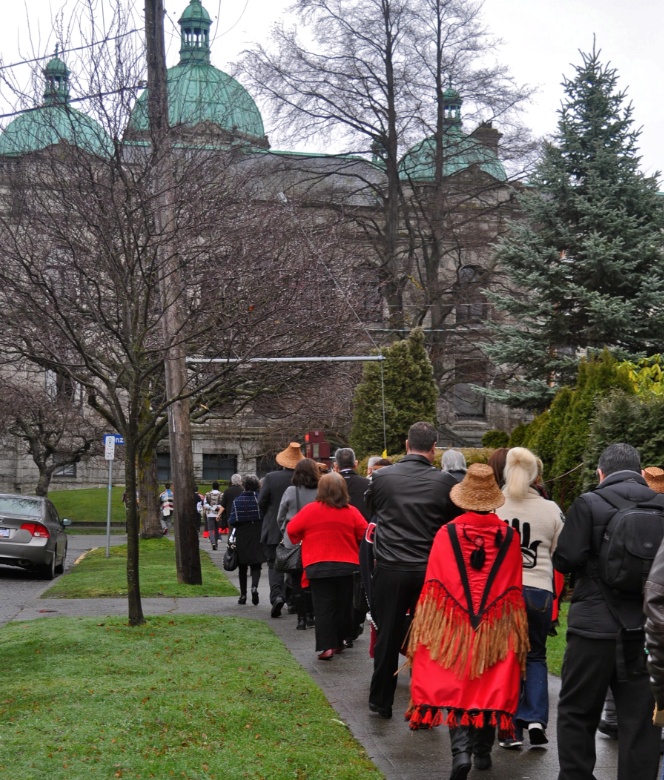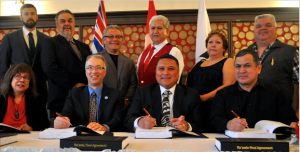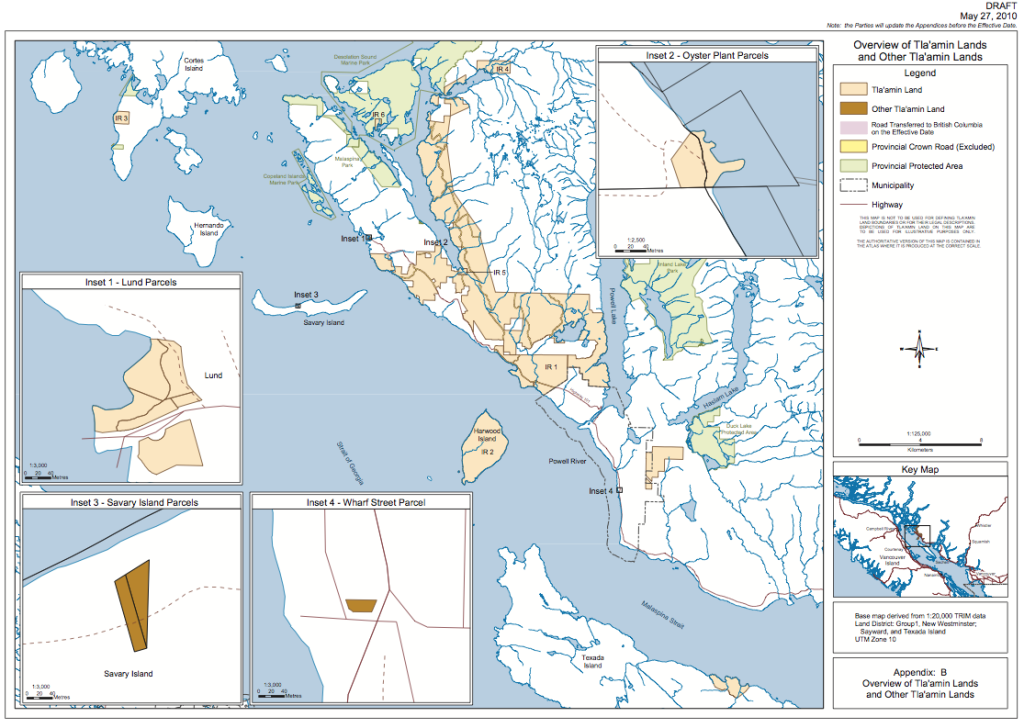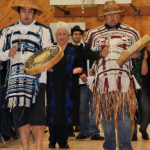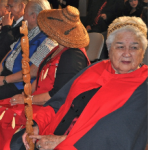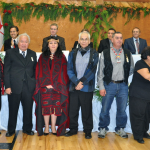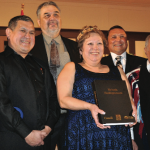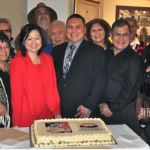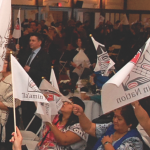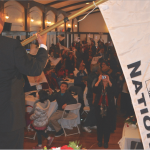The Long Journey to Tla’amin Treaty
It has been a very long road to treaty for the Tla’amin people. Even before Sliammon Nation (the English name for Tla’amin) entered the British Columbia treaty process in 1994, there were leaders with the vision that someday there would be ‘No more Indian Act’.
CHANGING OUR WORLDS
The first stories about Sliammon’s treaty began appearing in 2005 on the pages of The Sentinel’s predecessor, Klahowya, and in the nation’s own newsletter, Neh Motl. It was in that year that Joe Gallagher, the head negotiator at the time, and Davis McKenzie wrote: “This process is about Sliammon self-government. We must remember that we have an inherent right to govern ourselves. No other government can give that to us, and it does not come from the Indian Act.”
THE WORK BEGINS
An agreement-in-principle was signed with the governments of Canada and B.C. in June 2003 and later ratified by community members. Work began in earnest at Sliammon on a huge range of items, from law-making and creating a constitution to evaluating resources and conducting comprehensive community planning. The then-chief, Walter Paul, told the Powell River Peak newspaper that a challenging time had begun for Sliammon. “Treaty is the tool that we need to have in place to move us forward. We can’t continue to sit here under the Indian Act and administer our own poverty. It doesn’t work.” Much background work was done on treaty, especially the constitution, over the next few years. The nation also focused on economic development as an agreement was signed with Plutonic Power (now Alterra) for the impacts of the transmission lines for a run-of-river hydro project that passed through Sliammon lands.
MAJOR COURT DECISIONS
Those years also saw major court decisions that would affect treaty talks and other issues, not only for Sliammon, but also for First Nations across Canada. Following on from the groundbreaking Calder, Sparrow, Guerin and Delgamuukw decisions in decades past came the Haida and Taku River decisions, all causing a seachange in thinking (if not in action) about Aboriginal rights and title, consultation and other key policies.
CLINT BECOMES CHIEF
Meanwhile, back at Sliammon, Clint Williams took over as chief in 2008, the job he has held ever since, as work intensified on the constitution and other matters essential to nation-building. Meetings continued at the treaty table and elsewhere with provincial and federal officials on many lands, resource and other issues. Frustration was felt by Sliammon negotiators as the federal government refused to discuss fisheries issues as part of a treaty settlement.
‘YES’ TO CONSTITUTION
A milestone was reached in October 2009 when 70 per cent of the nation’s voters gave their approval to the Tla’amin Constitution, a significant step toward achieving a modern-day treaty.
FINAL AGREEMENT
On June 9, 2010, federal, provincial and Tla’amin negotiators reached agreement on the essential elements of the draft Tla’amin Final Agreement. Treaty negotiations concluded when the three parties initialed the final agreement on October 21. The vote on the final agreement proved difficult through 2012, as even families were split on whether to go ahead with treaty. In May, the Sliammon Treaty Society hosted former Assembly of First Nations national chief Shawn Atleo and a delegation of guest speakers to provide their vision on self-government and moving forward beyond the Indian Act at a community session themed ‘New Beginnings’. But still there were court hearings and even blockades of the main voting centre before Sliammon members eventually approved the agreement by a narrow margin on July 10, 2012.
BC, CANADA SAY OKAY
The Tla’amin Final Agreement Act was ratified by the BC Legislature on March 14, 2013, and the deal received royal assent. The signing of the agreement by the three parties was completed on April 11, 2014, when, on behalf of Canada, then-federal Aboriginal Affairs minister, Bernard Valcourt, signed off. A few days before, the Government of Canada introduced legislation for ratification by Parliament. That legislation received royal assent on June 19, 2014.
BC Treaty Process consists of six stages
-
Stage 1: Statement of Intent to Negotiate
A First Nation files with the Treaty Commission a statement of intent (SOI) to negotiate a treaty with Canada and BC. The SOI must identify the First Nation’s governing body for treaty purposes and the people that body represents and show that the governing body has a mandate from those people to enter the process. The SOI must describe the geographic area of the First Nation’s distinct traditional territory and identify any overlaps with other First Nations.
-
Stage 2: Readiness To Negotiate
The Treaty Commission must convene an initial meeting of the three parties within 45 days of accepting a statement of intent. For most First Nations, this will be the first occasion on which they sit down at a treaty table with representatives of Canada and BC. This meeting allows the Treaty Commission and the parties to exchange information, consider the criteria for determining the parties’ readiness to negotiate and generally identify issues of concern. The meeting usually takes place in the traditional territory of the First Nation. The three parties must demonstrate that they have a commitment to negotiate, a qualified negotiator, sufficient resources, a mandate and a process to develop that mandate and ratification procedures. The First Nation must have begun addressing any overlaps. The governments of Canada and BC must have a formal means of consulting with third parties, including local governments and interest groups. When the three parties have everything in place, the Treaty Commission will declare the table ready to begin negotiating a framework agreement.
More info: http://www.bctreaty.net/files/sixstages.php
-
Stage 3: Negotiation Of a Framework Agreement
The framework agreement is, in effect, the “table of contents” of a comprehensive treaty. The three parties agree on the subjects to be negotiated and an estimated time frame for stage four agreement-in-principle negotiations. Canada and BC engage in public consultation at the regional and local levels. A municipal representative sits on the provincial negotiation team at each treaty table.
More info: http://www.bctreaty.net/files/sixstages.php
-
Stage 4: Negotiation Of An Agreement In Principle
This is where substantive treaty negotiations begin. The three parties examine in detail the elements outlined in their framework agreement. The goal is to reach agreement on each of the topics that will form the basis of the treaty. These agreements will identify and define a range of rights and obligations, including: existing and future interests in land, sea and resources; structures and authorities of government; relationship of laws; regulatory processes; amending processes; dispute resolution; financial component; fiscal relations and so on. The agreement in principle also lays the groundwork for implementation of the treaty.
More info: http://www.bctreaty.net/files/sixstages.php
-
Stage 5: Negotiation to Finalize a Treaty
The treaty formalizes the new relationship among the parties and embodies the agreements reached in the agreement in principle. Technical and legal issues are resolved at this stage. A treaty is a unique constitutional instrument to be signed and formally ratified at the conclusion of Stage 5.
More info: http://www.bctreaty.net/files/sixstages.php
-
Stage 6: Implementation of the Treaty
Long-term implementation plans need to be tailored to specific agreements. The plans to implement the treaty are put into effect or phased in as agreed. With time, all aspects of the treaty will be realized and with continuing goodwill, commitment and effort by all parties, the new relationship will come to maturity.
More info: http://www.bctreaty.net/files/sixstages.php


